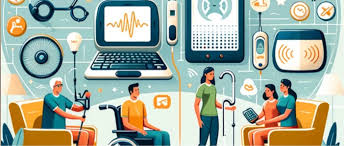INFOGRAPHIC FOR CURRENT AND FUTURE TRENDS IN ASSISTIVE TECHNOLOGY
- rnapalan
- Jun 13, 2024
- 2 min read
Updated: Jun 20, 2024

Assistive technology has been steadily evolving and making a significant impact in classrooms. As we move towards the future, the role of assistive technology in enhancing learning experiences for all students, including those with diverse needs, will help foster an inclusive and supportive learning environment where assistive technology can truly thrive and benefit all learners (ARBINO, 2024).
Current trends in assistive technology are tools to help with literacy, while artificial intelligence will have an impact on assistive technology (Strap Tech, 2024).
ASSISTIVE TECHNOLOGY DISCUSSION
As a paraeducator for the Sped department, I had the opportunity to use assistive technology tools like text-to-speech and speech-to-text application tools that are built within both Microsoft 365 and Google Suite for Education. According to Lo (2022), Microsoft Note can serve as a digital note-taking tool for students. Since our students utilize Google Suite tools, I have used the various accessibility tools that are built within each Google Apps. For example, our students use the voice typing tool to dictate notes within Google Docs. Our multilingual students also use Google Translate during class to enable them to understand and learn new English words.
With every student having a Chromebook, students can use various technology tools to help assist with instruction. Adobe Acrobat has a text-to-speech feature that allows students to build connections with words and for some help with phonemic meaning. According to Keelor et al., (2023), text-to-speech (TTS) tools help students with dyslexia; improving their comprehension of the reading material (p.480). Technology plays an important role in making standards-aligned curriculum and instruction accessible to all students. (Kroesch et al., 2022, p.158)
Reference
Keelor, J. L., Creaghead, N. A., Silbert, N. H., Breit, A. D., & Horowitz-Kraus, T. (2023). Impact of text-to-speech features on the reading comprehension of children with reading and language difficulties. Annals of Dyslexia, 73(3), 469-486. https://doi.org/10.1007/s11881-023-00281-9
Kroesch, A. M., Jozwik, S., Douglas, K. H., Chung, Y., Uphold, N. M., & Baker, E. (2022). Using technology to support academic learning. SAGE Publications. https://doi.org/10.1177/00224669211070563Links to an external site.
Lo, L. (2022, August 11). Free assistive tech tools that support academic success. Edutopia. Retrieved June 10, 2024, from https://www.edutopia.org/article/free-assistive-tech-tools-support-academic-successLinks to an external site.
Snelling, J. (2022, August 1). ISTE. Lo, L. (2022, August 11). Free assistive tech tools that support academic success. Edutopia. Retrieved June 10, 2024, from https://www.edutopia.org/article/free-assistive-tech-tools-support-academic-successLinks to an external site.




Comments